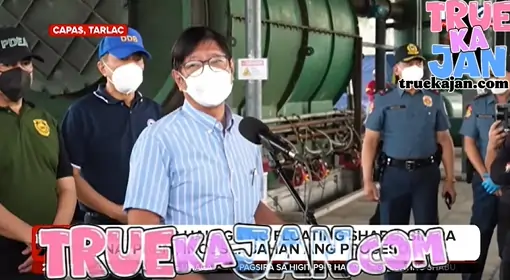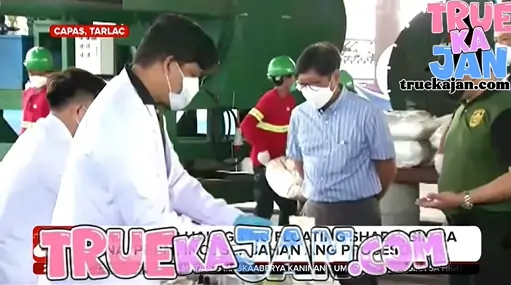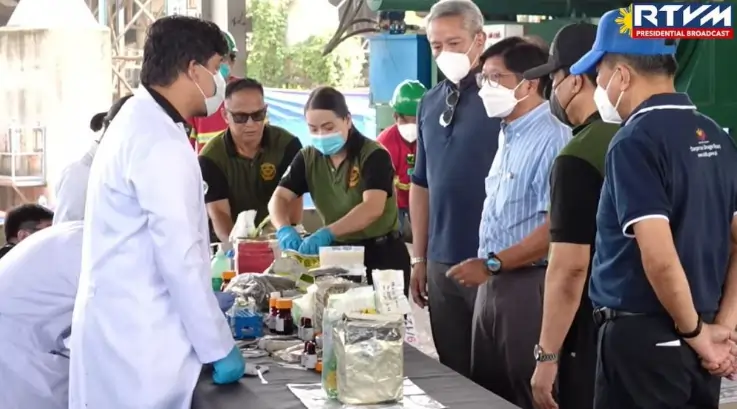
Introduction: A Watershed Moment in the Drug War
On 25 June 2025, a column of gray smoke rose above Capas, Tarlac as 1.53 metric tons of methamphetamine (“shabu”), cocaine, marijuana, and ecstasy—valued at P9.4‑Billion Drug Disposal —were reduced to inert ash. President Ferdinand R. Marcos Jr. personally pressed the ignition switch, marking the largest single P9.4‑Billion Drug Disposal in Philippine history.pna.gov.ph
How the Contraband Drifted Ashore
Between February and May 2025, fishermen from Zambales to Cagayan hauled in waterproof packs bobbing in coastal currents. Initial field tests by the Philippine National Police (PNP) and Philippine Drug Enforcement Agency (PDEA) confirmed 1,304 kg of shabu worth ₱8.87 billion, plus 226 kg of mixed narcotics seized in follow‑up stings—pushing the running total to ₱P9.4‑Billion Drug Disposal.(pia.gov.ph)
Maritime investigators believe the bundles were jettisoned by “mother ships” serving as floating warehouses. When a rendezvous fails—often after spotter‑plane or coast‑guard contact—crews dump cargo tied to flotation devices, leaving smaller boats to retrieve them later. Sometimes, tides and monsoon winds do the pickup instead, sweeping the stash toward unsuspecting communities.

The Fisherfolk Factor
Unlike many seizures that begin with surveillance intel, this record haul started with ordinary fishers practicing bayanihan. They radioed barangay officials rather than cash‑strapped smugglers offering finder’s fees. President Marcos credited them for “saving many of our countrymen” from addiction and death.bworldonline.com
Securing the Evidence
Once ashore, the drugs moved under armed escort to PDEA’s chemical laboratory in Quezon City. Each package received bar‑coded seals, high‑resolution photographs, and GC‑MS (gas‑chromatography mass‑spectrometry) profiling to satisfy Rules of Evidence—even though no suspects had been arrested. With public trust shaken by historical cases of “recycled” shabu, PDEA streamed inspections live and invited journalists to swab‑test random samples.

Why Thermal Decomposition?
Destruction used Clean‑Leaf International’s rotary‑kiln incinerator, pre‑heated to 700 °C. At this temperature, methamphetamine hydrochloride dissociates into benign compounds—chiefly CO₂, water vapor, and trace chlorides—with independent chemists on‑site to verify exhaust quality. Four ash samples, one from each 30‑minute burn cycle, later tested negative for all controlled substances.pna.gov.ph
Environmental engineers note that thermal decomposition consumes only 2 % of the fossil fuel required to run a conventional cement kiln, while achieving a 99.99 % destruction efficiency. Scrubbers captured acid gases, and the cooled slag was bound into concrete pavers for non‑structural use, closing the loop on hazardous waste.
A Shift From “Tokhang” to Transparency
Since taking office in 2022, Marcos has pushed a “balanced, humane, and evidence‑based” narcotics policy—distancing himself from the deadly tactics that plunged his predecessor into an International Criminal Court trial. In lieu of extrajudicial indicators, the administration now highlights seizure value (₱62 billion since June 2022) and rehabilitation enrolments.bworldonline.com
Mapping Maritime Narcotics Routes
The West Philippine Sea, despite geopolitical tension, remains a preferred corridor for meth traffickers sailing from the “Golden Triangle.” Packages travel aboard fishing trawlers, supply barges, and even ballast tanks of bulk carriers. Analysts at the UN Office on Drugs and Crime pinpoint at least three recurring drop‑zones:
- Scarborough Shoal Corridor – deep waters ideal for ship‑to‑ship transfers;
- Ilocos Current Drift – strong northerly flow that can keep contraband afloat for weeks;
- Babuyan Channel Gate – a choke point smugglers exploit when steering toward Taiwan.
The 2025 seizure touched all three corridors, underscoring their operational relevance.
Technology Force‑Multipliers
PDEA’s Maritime Drug Interdiction Task Group now fields AI‑enabled drift‑models that predict where dumped contraband might land within 12 hours, guiding coast‑guard patrols and fishermen advisories. The Philippine Space Agency’s Diwata‑3 microsatellite provides 3‑meter‑resolution images, detecting anomalous sea‑surface reflectance—such as plastic‑wrapped packages—in daylight passes.
Legal Tightening: From Possession to Disposal
Under Republic Act 9165, seized drugs must be destroyed within 24 hours after a court order, or, when no suspect exists, upon a sworn certification by the PDEA Director‑General. The June 25 event showcased the paper trail: request to the Dangerous Drugs Board, chain‑of‑custody logs, prosecutor concurrence, DOJ clearance, and final “Authority to Dispose.” This multi‑signature workflow aims to eliminate discretionary loopholes that criminal syndicates once exploited.
Regional Ripple Effects
Neighboring Indonesia, Malaysia, and Vietnam all reported upticks in “ghost bales” of meth coinciding with Philippine seizures, hinting at a syndicate dispersal strategy to dilute loss. ASEAN security chiefs, meeting in Phnom Penh last week, agreed to synchronize maritime radars and share Automatic Identification System (AIS) spoofing alerts in real time.
Economic Stakes: Counting the Opportunity Cost
At street level, a gram of shabu sells for ₱6,000‑₱8,000. The destroyed cache, had it reached users, equals roughly 1.2 billion “bumps”—enough to satisfy national demand for four to six months. Economists estimate that associated crime costs (property theft, lost productivity, health care) typically triple the retail drug value. By that metric, the P9.4‑Billion Drug Disposal pre‑empted up to ₱30 billion in downstream social damage.
Community Impact Stories
In coastal Sitio Pitas, Zambales, fisherfolk who surrendered 350 kg of floating packs received livelihood grants: new fiberglass bancas, solar‑powered cooler boxes, and insurance coverage under the Marcos administration’s “Bagong Pilipinas Serbisyo Fair.” Residents told local media they now serve as volunteer coast‑watchers, equipped with satellite phones and a direct line to PCG District North Luzon.
The Science Behind Shabu’s Buoyancy
Crystal meth is denser than seawater, but traffickers encase it in multilayer vacuum packs, bubble wrap, and styrofoam floats. Cartels may also lace bundles with GPS beacons that transmit location once surfaces breach. PDEA divers recovered two such beacons embedded in the June shipments; forensic teardown traced the chips to a Shenzhen‑based manufacturer, yet serial numbers were intentionally milled off, stalling the trail.
Forensics and the Mystery of Origin
Chemical isotope analysis performed at the University of the Philippines‑Diliman revealed precursor ratios consistent with laboratories in Guangdong and Fujian, suggesting transshipment through a regional “super‑lab.” However, maritime logs show no Chinese‑flagged fishing vessel in AIS range during the likely dump window, implying either transponder “dark gaps” or use of stateless boats.
Human‑Centered Enforcement
Interior and Local Government Secretary J.V. Remulla stressed rehabilitation: “Each gram destroyed is one less trigger for addiction, but campaigns must pair enforcement with treatment.” The Department of Health earmarked ₱250 million to upgrade six regional treatment centers, while TESDA offers skills programs for recovering users—shifting the narrative from punitive to restorative.
Media Transparency as Deterrence
Inviting television crews to the incineration served a dual purpose: reassure citizens and warn syndicates that seizures will not quietly re‑enter supply chains. Drone footage of the fireball went viral, clocking 12 million views and trending #SeaShabuNoMore for 48 hours on X (formerly Twitter).
Communication scholars argue that such spectacles foster “perceived certainty of loss,” a psychological deterrent rivaling the threat of arrest.
Critics Speak Up
Yet civil‑society groups caution against over‑reliance on seizure metrics. Sentro ng Karapatang Pantao noted that big hauls often mask gaps in demand‑reduction strategy. They urge more funding for mental‑health services, pointing out that only 4 % of the 2025 anti‑drug budget targets prevention and rehabilitation combined.
Maritime Capacity Gaps
The Philippine Coast Guard operates 15 monitoring stations along a 36,000‑km coastline—an average of one station for every 2,400 km. Admiral Ronnie Gil Gavan admits the ratio is “woefully inadequate” and is lobbying Congress for ₱12 billion to procure four 84‑meter multi‑role response vessels equipped with unmanned aerial systems.
International Law and High Seas Jurisdiction
Under the United Nations Convention on the Law of the Sea (UNCLOS), coastal states may board stateless vessels suspected of illicit trafficking on the high seas. Manila is negotiating mutual legal assistance treaties with Taiwan and Palau to streamline extradition of crew arrested in joint operations—closing jurisdictional loopholes that smugglers exploit by hopping EEZ boundaries.
Toward a Whole‑of‑Nation Approach
The June 25 destruction was not an isolated event but a node in a wider strategy—integrating maritime domain awareness, community engagement, evidence‑backed prosecution, and post‑seizure transparency. The Cabinet Cluster on Security, Justice, and Peace now meets monthly to audit not just arrests or kilos seized, but rehabilitation graduation rates and recidivism metrics.
Conclusion: Fire and Accountability
The P9.4‑Billion Drug Disposal in Capas stands as both spectacle and statement: the seas are no longer a low‑risk corridor, and seized contraband will not linger in evidence lockers where corruption can resurrect it. True victory, however, will be measured in communities kept whole—families unbroken by addiction, fishermen empowered rather than entangled, and a justice system that values life as much as law.
As the smoke cleared on that June afternoon, trace analyses confirmed zero narcotics in the final (ash.pna.gov.phbworldonline.com) And for a brief moment, the horizon between the West Philippine Sea and the Sierra Madre felt just a little safer.
